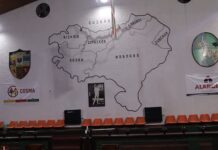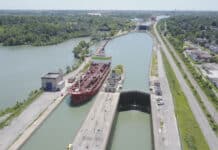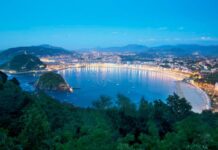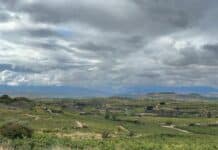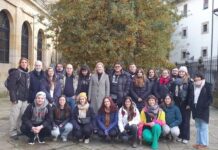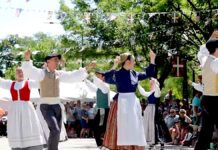This article was translated by John R. Bopp
This documentary will air on ETB2 at 10:00pm on Monday, January 6, 2013
A personal reflection about this documentary here
This article was written before we saw the documentary, based on reviews, trailers, producers’ explanations, etc. Now, after having seen it, we reaffirm each and every one of the questions, doubts, and perceptions we transmitted in this article.
At the Zinemaldia, or San Sebastian International Film Festival, a documentary analyzing another documentary has aired. The subject matter is “Im Lande der Basken (In the Land of the Basques” (1944), directed by Herbert Brieger, one of the preeminent directors in German Nazi propaganda filmmaking.
The documentary that debuted at San Sebastian is called “The Basque Swastika (A Swastika over the Bidassoa)”, which discusses the time of the Nazi occupation in the Northern Basque Country from 1939 to 1945 (because in the Southern Basque Country, the totalitarian occupation lasted far, far longer, even after Franco’s death, with the blessing of Western democracies).
We haven’t seen the documentary, so we can’t really speak about its exact content. But we have to admit that in its advertising, there are things that have left us rather confused (that’s one way of putting it).
- The title in English is confusing; it could lead someone to think, given the SS symbol, that there was a pro-Nazi Basque movement.
- We’re confused by the insinuation made on the on the documentary’s website front page, which in some way sows doubt regarding the existence of a secret pact (a “hidden alliance”) between the Nazi régime and the Basques. This is repeated throughout the trailers.
- We’re confused by how the trailer exclusively highlights the existence of “documented encounters or contacts some Basque nationalists had in those days with the Nazi occupiers,” to then go on to say that this is “the story of the Basques who suffered the Nazi occupation”, thereby creating a dichotomy between the movements of the nationalist ideology and the interests of the Basque population as a whole.
- We’re confused that another of the trailers starts with scenes from Mauthausen, and a title that identifies the place saying “thousands of prisoners were shot at this camp; among them were many Spanish republicans”.
- We’re confused by the use of “mysterious film” to refer to the German documentary, which is presented as the “unknown story of the Third Reich on both sides of the Bidassoa”.
- We’re confused by the appearance of traditional Basque china decorated with swastikas used as a man element in the documentary.
So yes, there are a lot of things that confused us. One very confusing aspect is how it claims to be “a documentary that is faithful to History,” meaning it depended on two assessors who are expert historians of that period: Santi de Pablo (who we imagine must be Santiago de Pablo) and Ludger Mess. Regarding this historical perspective, Im Lande der Basken (1944). El País Vasco visto por el cine nazi, by Santiago de Pablo and Teresa Sandoval, about this documentary, is worth reading, despite being rather lengthy.
All this leaves us rather confused, because both historians claim in their works the existence of contacts between specific people who were militant within the ranks of Basque nationalist (aka, the BNP/PNV) and certain responsible parties from Nazi Germany were isolated instances that went against the policy, regulations, and actions of Basque Nationalism as a whole. It was a democratic movement that had, for many years preceding the war, from the very start of the rise of National Socialism, been against that ideology.
It was so against that ideology that it even stopped using swastikas. Until then, they had been common in Basque culture, but they were consciously abandoned in the 1930s, to avoid any type of relationship between Basques and Basque Nationalism and Nazi totalitarian ideology. The same thing happened throughout Europe, by all those who didn’t share that ideology. The Swiss railway firm ASEA, which had used swastikas on their locomotives’ identification plaque as a traditional symbol of good luck, dropped them in the 1930s. These extraordinary machines were used on the Ferrocarriles Vascongadas line and some are still preserved at the Basque Railroad Museum, as explained here. These plaques have even been publicly denounced in newspapers, because of their close relationship with Nazism.
It’s true, we haven’t seen the documentary. But as you, dear readers, know, they’re kind of like newspaper headlines: many people only read them, without digging deeper to get the full story; others read them, but with their opinions already colored by the headline, even though it may not coincide with the information presented in the article. Moreover, we have read the conclusions some Spanish “media” outlets have already reached, also without having seen it, as it’s enough to just go against Basque nationalism.
We don’t like the opinion given regarding the German documentary, inasmuch as it claims that it was trying to present a pure, isolated race, apart from the Spanish and French, and therefore, worthy of being considered enough to be equal to the Germans in the 1000-Year Riech that was to come to dominate Europe. So, were that true, would that mean that for the German Nazis, the French and Spanish weren’t? Absurd questions aside, we don’t like it because, if you’ve noticed, the layout, the documentary concept, the idea behind many of the shots, and even the title, are all extremely similar to the documentary Orson Welles filmed years later, also in the Northern Basque Country. Might the American director have been a Nazi in disguise, trying to highlight the purity of the Basque race and its inclusion in the troupe of “unpolluted races”? It seems far more likely to us that, at least in the case of Orson Welles, what guided him was a romantic look that was trying to capture the personality of a People, the Basque People, who were trying to survive in that corner of Europe.
In the years the documentary was filmed in, when it’s insinuated that that secret pact, agreement, coming together, convergence between Nazis and Basque Nationalists, the latter were in jail, or in exile, struggling against all totaliarianisms. It was something they had already done, during the Spanish Civil War, when the so-called Western Democracies turned their back on the Republic; they did so when the Soviet Communists signed an agreement with the Nazis to divide up Poland, and they did so again when, again, Western Democracies forgot their principles and accepted the régime of Franco, that putative son of Hitler and Mussolini, in international fora. That is the real story, the truth, History standing up, showing that any possible meetings between isolated members of the BNP/PNV, acting of their own accord, had with Nazis, is nothing more than a mere anecdote. And it’s far less worse than the permissiveness France and Great Britain showed with the German conquests that occurred prior to the invasion of Poland; the USSR-German pact to invade and divide up that country; or the Francoist uprising, with its domestic and foreign support, and the forty years of misery that that general brought with him.
But it’s true. There were Basque Nazis, Nazi admirers, friends of the Nazis, pro-Nazis, and some who cheered every one of their actions during the time they ruled Germany. Those were the ones who allied themselves with the Francoists, who fought against the Republic, and who supported Franco’s criminal régime. All of them were considered “good Spaniards”, which, for some, that small mistake of being a totalitarian fascist, is a mere peccadillo; a peccadillo for those who think that this person’s dictatorship and its followers were the lesser evil, and that things weren’t all that bad (we imagine that for them and theirs, they very well may not have been).
We’ll leave you with the report published in The Hollywood Reporter, the documentary’s trailers, and a reference to what reading can be done by those who will cling to a burning nail to prove that Basque nationalists are nothing more than bad Spaniards, demons with tails and horns.
The Hollywood Reporter – 25/9/2013 – USA
The Basque Swastika: San Sebastian Review
A World War II documentary having its world premiere in San Sebastian holds special interest for festival audiences. The Basque Swastika is a rare film that looks at the Nazi occupation of the Basque areas of France and Spain. Featuring interviews with survivors and children of residents, as well as extensive newsreel footage, the film opens a compelling window on Basque resistance and cooperation with the Nazis. Some of the images are especially resonant, including newsreel footage of German planes crashing on the beach at San Sebastian and another scene of German boots lined up on the sand at Biarritz while the occupying soldiers took advantage of a little R and R. Although the film may not have much life beyond this particular festival, it was well received here and proved quite eye-opening.
(Follow) (Automatic translation)
———————————————
TRAILER The Basque swastika (English)
———————————-
Una esvástica sobre el Bidasoa (Trailer) (Spanish)
———————————-
The Basque Swastika, teaser
———————————
Libertad Digital – 22/9/2013 – Spain
Un documental narra que el PNV negoció con los nazis la independencia vasca
El documental Una esvástica sobre el Bidasoa, que fue estrenado ayer en el Festival Internacional de Cine de San Sebastián (Zinemaldia), revela la existencia de contactos entre representantes nacionalistas vascos y dirigentes nazis durante la Segunda Guerra mundial. El filme recoge el testimonio de testigos de la época, historiadores y documentos alemanes, según los cuales durante la ocupación de Francia, hubo un acercamiento de dirigentes de PNV con nazis para tratar de asegurarse de los alemanes una hipotética independencia de Euskadi. “Había que jugar a ganador por una vez” confirma los contactos el exalcalde de San Sebastián Ramón Labayen (PNV), que añade que “había cierta esperanza de que los alemanes nos apoyaran frente a Franco.”
(Follow) (Automatic translation)
Last Updated on Sep 14, 2021 by About Basque Country




